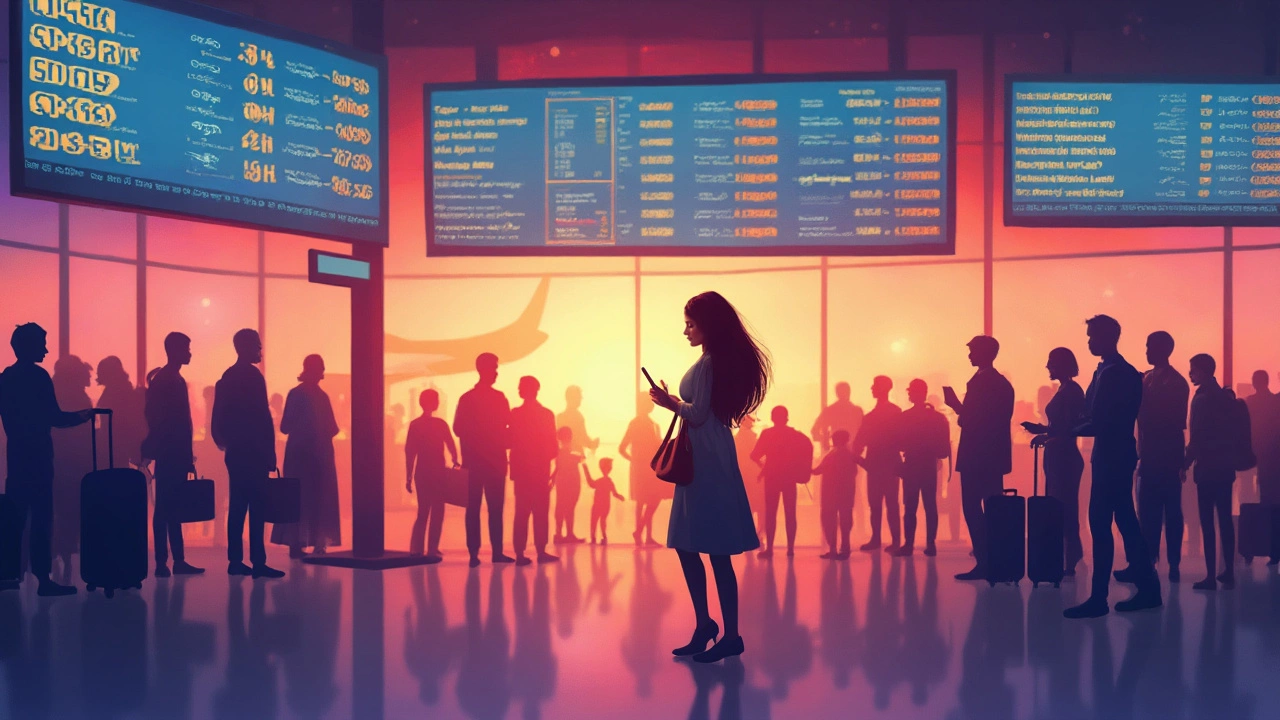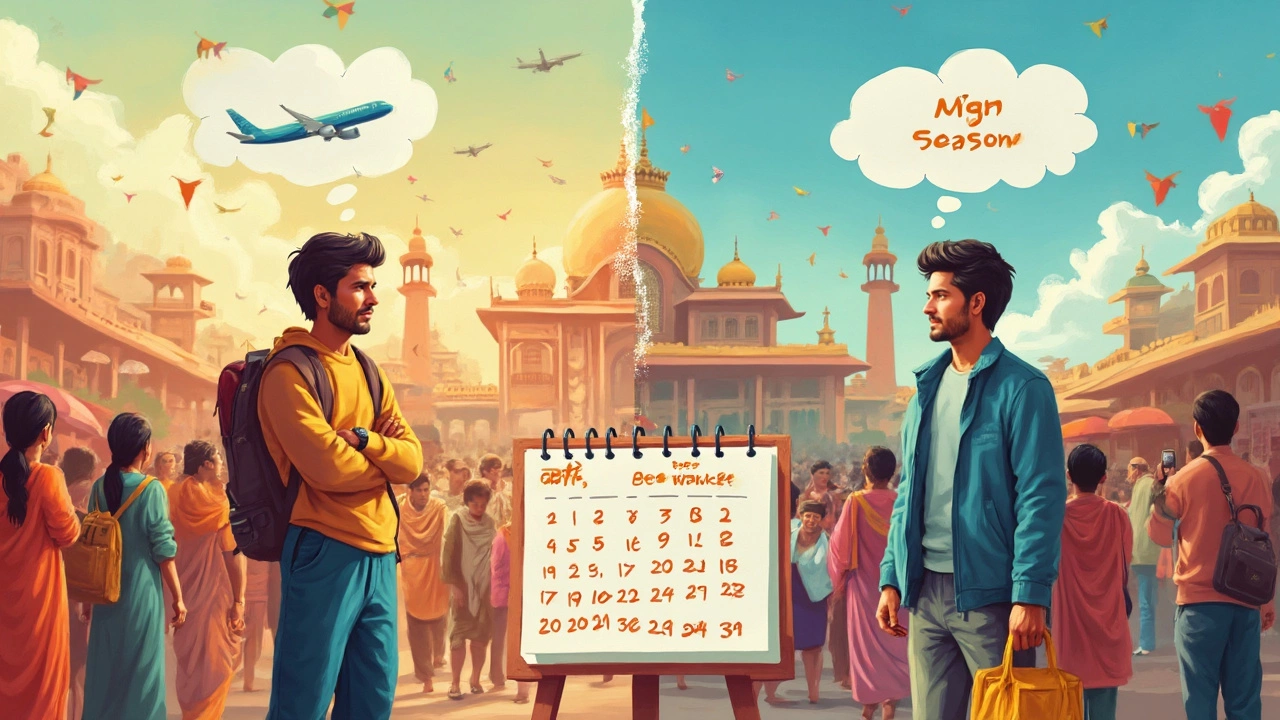Booking flights to India has a bad habit of playing with your nerves—and your wallet. If you’ve ever watched airfare change by the day (or even the hour), you know how frustrating it gets. Here’s the straight truth: There’s no magic number that works every single time, but there are patterns that can save you hundreds if you know when to jump.
Airlines use algorithms that study demand, holidays, and even your search habits. Ever noticed ticket prices jump after you look at a route a few times? That’s not your imagination. India is a hotspot with flights from all corners of the globe, so timing your booking isn’t just about being early—it’s about being smart.
If you want to save real cash and avoid the panic of last-minute price spikes, forget the myths and focus on what actually works in 2025. This article spills what you actually need to know.
- Why timing matters: The reality behind flight prices
- The best timeframes to book flights to India
- Seasonal trends and key dates to watch
- Smart strategies for scoring cheaper tickets
- Pitfalls: When waiting or booking early can backfire
Why timing matters: The reality behind flight prices
If you’ve ever stared at your screen in disbelief as flight prices changed within hours, you’re not crazy. Airlines use dynamic pricing, meaning ticket prices go up and down depending on a bunch of factors—demand, major holidays, and how many seats they’ve already sold. For anyone hoping to book flights to India without busting their budget, timing is everything.
Here’s the deal: as the plane fills up, prices tend to rise. But in the very beginning, airlines might push fares lower to get those first few seats sold. Around six to eight months before big travel seasons—like Diwali, Christmas, or summer vacation—some international airlines quietly open up cheap fares, but those can disappear fast.
Another big thing? Most flight routes to India are heavily competitive, especially from spots like the U.S., UK, and Australia. When there’s a holiday coming or school breaks are on the way, you can bet ticket costs will start climbing as soon as airlines spot the extra demand in their data. Algorithms catch on quick, especially when lots of folks start searching for the same dates. That’s why you’ll see a small spike after a few Google searches, even if you’re just checking prices for fun.
There are even days of the week when prices shift. According to research by sites like Hopper and Skyscanner, booking on Tuesday or Wednesday sometimes brings in lower prices, but it’s not a guarantee. What matters more is watching the trends—set price alerts, track ticket prices for a while, and be ready to pounce when a good rate shows up.
Bottom line: booking whenever is a risky move. Flight prices to India are a moving target, and booking at random can easily cost you double what someone just a little more strategic might pay.
The best timeframes to book flights to India
If you’re aiming for the cheapest India flights, the window you pick matters way more than you think. Online booking data from sources like Google Flights and Skyscanner in the past three years show a pretty clear trend: The best time to book flights to India is about 2-6 months ahead of your planned departure date for most travelers. Booking less than 2 months out? Expect price hikes unless you luck out with a last-minute deal. More than 6 months in advance? You risk paying a premium before sales even start kicking in.
Here’s a breakdown of what the data looks like:
| Booking in Advance | Fare Trend |
|---|---|
| 7-12 months | Highest fares, minimal deals |
| 4-6 months | Good deals, decent availability |
| 2-3 months | Best prices, more flash sales |
| 2-4 weeks | Prices often spike, riskier |
| <2 weeks | Highest risk for expensive tickets |
People flying from the US, UK, Australia, or Canada to India usually see the best rates if they book flights roughly 70-90 days ahead. This span often lines up with specials that airlines roll out to fill up empty seats without giving away tickets too early.
If you’re traveling during major Indian holidays like Diwali or Christmas, booking even earlier—around 4-7 months in advance—is smart. For flights in off-peak seasons, airlines can dump prices suddenly, so monitoring a few months out can win you that jackpot fare.
- Mid-week departures (Tuesday or Wednesday) are often cheaper than weekends.
- Prices can drop during shoulder seasons: April, May, late September, and early October if you avoid major festivals.
- Setting fare alerts lets you spot sudden bargains rather than checking obsessively.
Remember, the real trick is watching, waiting for the sweet spot, then pouncing when that price feels right. Don’t assume “earlier is always better”—airlines count on people panicking or overplanning. Just stick to the 2-6 month zone for India, and your wallet will thank you.

Seasonal trends and key dates to watch
If you're trying to lock in the cheapest rates on flights to India, timing your booking around the seasonal swings and big holidays is half the battle. Prices jump and drop depending on what’s happening both in India and around the world. Here’s what you should actually know before you hit book.
India’s peak travel season runs from late October to March—the weather’s nicer, so demand (and prices) shoot up. Within this period, December and January are almost always the most expensive months because of Christmas, New Year’s, and school breaks. If you check historical ticket prices, these months can see fares that are 20-40% higher than other times. On the flip side, the off-peak season from mid-April to September (the hottest and rainiest months) usually brings the lowest fares. If you’re chasing the absolute lowest, shoot for flights during the monsoon window—airlines drop prices to fill seats.
| Season | Months | Flight Price Trend |
|---|---|---|
| Peak (High) | October – March | 20-40% above average; especially Dec-Jan |
| Shoulder | April & September | Usually moderate rates |
| Off-Peak (Low) | May – August | Often 25-45% below peak; best bargains |
It’s also crucial to watch out for key festivals and travel dates. Indian holidays like Diwali (usually October or November), Holi (March), and local long weekends trigger sudden demand. Even if you’re not celebrating, airlines know lots of people want to visit family or travel then, so ticket prices spike.
- Diwali: The biggest festival, moves each year (October-November). Fares jump for about two weeks before and after.
- Christmas/New Year: Both international and domestic travelers pile onto routes, so expect high fares from mid-December to mid-January.
- Summer school holidays: From late May to June, families in India travel a ton. Even off-peak, there’s a short bump in prices.
- Republic Day (Jan 26), Independence Day (Aug 15), and Gandhi Jayanti (Oct 2): National holidays mean fuller flights and pricier seats, especially on domestic connections.
Not all routes are equal either. Flights from North America, Europe, and Australia to Indian cities like Delhi or Mumbai see their own peaks due to local holidays and university schedules. For example, fares from the US to India soar in late November for Thanksgiving, not just during Indian holidays. If you want the cheapest India flights, use fare calendars and check dates a few months ahead—just avoiding the wrong week can make a big dent in your costs.
Smart strategies for scoring cheaper tickets
If you want to stop overpaying for flights to India, you need a plan. Here’s what works if you’re serious about finding cheap tickets—no luck or magic involved.
- Track Prices Early: Start checking fares at least four months before your travel date. Most folks end up saving around 15-20% by watching trends instead of booking on impulse. Tools like Google Flights and Skyscanner can alert you when prices drop or spike.
- Book at the Right Time: For most flights to India from the US or Europe, the sweet spot is usually 2-5 months before departure. Booking too early or too late can mean higher prices. But if you’re targeting peak season (December and January), lean toward the 4-6 month range.
- Be Flexible with Dates: Small changes, like moving your trip by just a day or two, can save a lot. Flights mid-week (like Tuesdays and Wednesdays) tend to be 10-12% cheaper than weekends, when demand goes up.
- Use Incognito Mode: Search for flights using private browsing, so booking sites can’t hike prices based on your search history. Price-boosting cookies are real, so don’t give them ammo.
- Try Alternate Airports: International flights to cities like Delhi, Mumbai, or Bengaluru are popular, but sometimes flying into less crowded airports or nearby cities can knock a big chunk off your ticket price.
- Set Fare Alerts: Airlines drop deals out of nowhere. Let websites work for you by setting up price alerts. You’ll get notified when fares hit your target range.
- Consider Layovers: Direct flights cost more. If you can handle a longer journey, consider booking with stopovers in places like Dubai, Doha, or Istanbul. These can cut costs, sometimes by $200 or more.
- Snag Deals from Airlines: Keep an eye on major airlines’ promo periods, especially during off-peak months. If you’re a student or under 26, some airlines have exclusive deals for you.
Here’s a quick look at recent price trends. According to 2024 data, these were the average round-trip fares from major U.S. airports to India during different booking windows:
| Booking Window | Avg. Price (USD) |
|---|---|
| 6+ months in advance | $1,250 |
| 4-6 months | $950 |
| 2-4 months | $830 |
| Less than 2 months | $1,150 |
| Last minute (less than 14 days) | $1,480 |
So, if getting the cheapest India flights is your goal, start early, stay flexible, and don’t let automated price jumps catch you off guard. A bit of effort beats “just getting lucky” every single time.

Pitfalls: When waiting or booking early can backfire
It's tempting to think, "I'll just book way ahead and get the lowest price," or, "Last-minute deals will save me." But neither move works for most people trying to snag the best book flights to India deals. Here's why timing can trip you up.
If you book more than 8 or 9 months in advance for India, airlines often haven’t released their cheapest seats yet. Those early fares are for business travelers or folks who absolutely must have a seat locked in. In fact, most flight search engines show higher prices that far out—there’s usually a dip in fares about five to six months before your travel date. Booking ultra-early rarely brings the lowest price.
On the other hand, waiting too long is risky—especially around Indian festivals, school holidays, and peak winter season. Data from travel sites like Skyscanner and Google Flights shows that fares for India commonly shoot up in the final 6-8 weeks before departure. Airlines know people get desperate, so those last-minute "deals" are mostly a myth on popular Asia routes.
Sometimes travelers hold out because they think there’ll be flash sales or error fares at the last minute. Sure, those happen, but not reliably and rarely for high-demand destinations like Delhi or Mumbai. If you see a price in your range between four and six months ahead, don’t keep refreshing for a miracle.
- Don’t wait for prices to drop during school breaks, Diwali, Holi, or Christmas—book as soon as you can for those times.
- Double-check visa requirements before buying super-early tickets. Travel rules for India can change with little warning.
- If you have flexibility, use date-search tools to check how fares change just by shifting your travel by a day or two.
- Watch out for non-refundable deals on flights booked too early—your plans might change, but your money won’t come back.
Bottom line? Keep your eyes open for price drops four to six months out from your preferred dates. Avoid the urge to book the very first fare you find, but don’t gamble on last-minute magic for India. Strike somewhere in the middle, and you’ll avoid the usual airfare traps.
